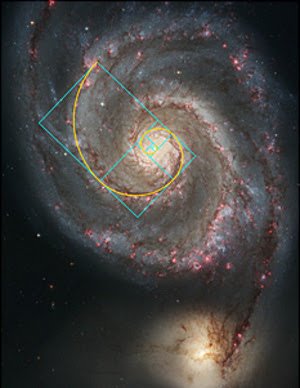I attended a presentation recently that included a discussion of the Fibonacci number sequence and golden spirals. We have discussed Fibonacci numbers and golden spirals here at Partial Ellipsis of the Sun before.
The Fibonacci number series begins as 0, 1, 1, 2, 5, 8, 13, 21, 34, 55, 89,144; each term is the sum of the previous two terms. The Golden Spiral is created using phi, the ratio of 1.6180. In mathematics, two quantities are in the golden ratio if their ratio is the same as the ratio of their sum to the larger of the two quantities thus:
The illustrations in the presentation included spirals that looked like this:
Of course, Golden Spirals look like this:
No one else in the audience seemed bothered by equal spacing on the spiral; it drove me bonkers. Folks commented on how beautiful the illustration was; but it was wrong!
The Golden Spiral can be seen in the Milky Way:
And in storm patterns:
It can also be used in image composition:
I brought the spiral conundrum to the kindergartners who all saw immediately that the spiral had to grow so the chambered nautilus could grow, too.
From the mouths of babes. . .
Speaking of babes, a shout-out to my co-teacher who turned 60 on the 6th. The Babylonians considered 60 the most sacred number and a resetting of the odometer to zero in their base-60 number system. Happy sexagesimal reset, Mary!
Does it drive you bonkers when illustrations are wrong?
^^^Thanksgiving Square Chapel, Dallas, TX
Steph
Christmas Eve at Great Sand Dunes National Park and Preserve. It was an extraordinary day shared with a herd of 30 elk. See if you can find them.
Happy Sandy Holidays!
The Fibonacci number series begins as 0, 1, 1, 2, 5, 8, 13, 21, 34, 55, 89,144; each term is the sum of the previous two terms. The Golden Spiral is created using phi, the ratio of 1.6180. In mathematics, two quantities are in the golden ratio if their ratio is the same as the ratio of their sum to the larger of the two quantities thus:
The illustrations in the presentation included spirals that looked like this:
Of course, Golden Spirals look like this:
No one else in the audience seemed bothered by equal spacing on the spiral; it drove me bonkers. Folks commented on how beautiful the illustration was; but it was wrong!
The Golden Spiral can be seen in the Milky Way:
And in storm patterns:
It can also be used in image composition:
I brought the spiral conundrum to the kindergartners who all saw immediately that the spiral had to grow so the chambered nautilus could grow, too.
From the mouths of babes. . .
Speaking of babes, a shout-out to my co-teacher who turned 60 on the 6th. The Babylonians considered 60 the most sacred number and a resetting of the odometer to zero in their base-60 number system. Happy sexagesimal reset, Mary!
Does it drive you bonkers when illustrations are wrong?
^^^Thanksgiving Square Chapel, Dallas, TX
Steph
Christmas Eve at Great Sand Dunes National Park and Preserve. It was an extraordinary day shared with a herd of 30 elk. See if you can find them.
Happy Sandy Holidays!

























































